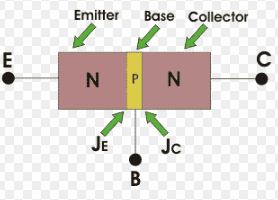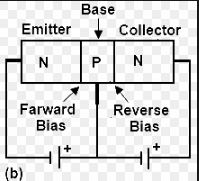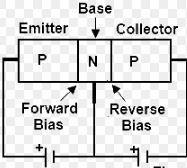Types of bipolar junction transistor
There are two types of Bipolar Junction Transistor (BJT) are given below;
- NPN bipolar junction transistor.
- PNP bipolar junction transistor.
NPN Bipolar Junction Transistor
In NPN transistor the current is conducted by the electrons as majority charge carriers as well as holes are minority charge carriers. The holes have positive charge and electrons have negative charge.
The NPN transistor consist two n type semiconductor materials which are separated by thin layer of p type semiconductor.
The NPN transistor has three terminal Emitter, Base and Collector. It has two PN junction namely Base to Emitter (B-E) junction and Collector to Base (C-B) junction.
The NPN bipolar junction transistor is mostly used because the mobility of electrons is higher than the mobility of holes.
Operating principle:
NPN transistor in forward biased mode, i.e. the emitter to base (E-B) junction of a transistor is forward biased by a battery VEE the collector to base (C-B) junction is reverse biased by a battery VCC.
If the voltage VEB exceeds the barrier potential which is 0.7 V for silicon and 0.3 V for germanium transistors then emitter to base (E-B) junction is forward biased.
In forward biased on the emitter base junction due to majority carriers in the n type free electrons flow towards the p type base this constitutes the emitter current IE .
After reaching the base region the free electron combine with the hole in base. Electrons combine with the holes in the base region they constitute the base current IB .
Most of the electrons are not combining with holes in base region. Because of the base is lightly doped and very thin.
Most of the electrons will diffuse to the collector region and constitute the collector current IC .
The collector current is produced due to the electrons injected from the emitter region is also called as injected current.
In this way, almost the entire emitter current flows in the collector circuit.
The conventional directions of emitter current IE , base current IB and collector current IC as shown in above figure.
IE = IB + IC
The base current is very small as compared to the collector current, so
IE = IC
PNP Bipolar Junction Transistor
In PNP transistor the current is conducted by holes as majority charges carriers as well as electrons are minority charges carriers.
The PNP transistor consist two p type semiconductor materials which are separated by thin layer of n type semiconductor.
The PNP transistor has three terminal Emitter, Base and Collector. It has two PN junctions namely Base to Emitter (B-E) junction and Collector to Base (C-B) junction .
Operating principle:
The working of PNP transistor is essentially similarly to NPN transistor.
Fig. shows an NPN transistor in forward biased mode, i.e. the emitter to base (E-B) junction of a transistor is forward biased by a battery VEE the collector to base (C-B) junction is reverse biased by a battery VCC.
If the voltage VEB exceeds the barrier potential which is 0.7 V for silicon and 0.3 V for germanium transistors then emitter to base (E-B) junction is forward biased.
In forward biased on the emitter base junction due to majority carriers that is holes in the emitter region to flow towards the base region. This constitutes the emitter current IE.
After crossing the emitter to base (E-B) junction holes reach the base region and combine with majority carriers that is holes which presence in the base region. The holes are combine with the free electrons in the base and the current flowing though it is called as base current IB .
Most of the holes are not combine with the electrons in the base region. This is because of the base is lightly doped and very thin.
Due to this holes did not get sufficient electrons for recombination. Hence most of the holes get back to the collector region the current produce in this region is collector current IC.
This collector current is also called as injected current because this current is produced due to the holes injected from this region.
Due to thermally generated carriers there is another small component of collector current. This current component is called as reverse saturation current (ICO) and is quite small.
In this way almost entire emitter current IE flows in the collector circuit.
In PNP current conduct by holes . However, in the external connecting wires, the current is still by free electrons.
The conventional directions of emitter currents IE , base currents IB and collector currents IE in respectively in fig. The emitter currents is the sum of the base and collector currents .
IE = IB + IC
Base current is very small as compared to collector current.
IE = IC





